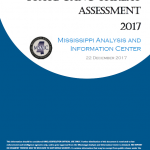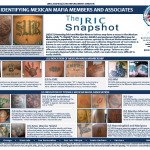The purpose of this assessment is to provide an overview of the international activities of the MS-13 criminal organization. The report is the result of the analysis of arrest records, law enforcement reports, deportation records, interviews, and observations conducted by members of the MS-13 National Gang Task Force (NGTF) regarding documented MS-13 members in the United States; Chiapas, Mexico; El Salvador; and Honduras. Violent MS-13 members have crossed international boundaries and key members have documented links between the United States and the countries addressed in this assessment.
17 search results for "MS-13"
Intelligence Fusion Centers, New Jersey
(U//LES) LulzSec Release: New Jersey Fusion Center MS-13 Using Game Consoles to Communicate
As of June 2010, MS-13 members in Los Angeles have directed operational activities of new MS-13 members in Birmingham, United Kingdom, using gaming consoles such as Sony Playstation and Microsoft Xbox 360. The MS-13 leaders appear to be taking advantage of the devices’ voice over internet protocol (VOIP), text chat, virtual world, and video teleconferencing features, which allow them to communicate with fellow gang members overseas.
Intelligence Fusion Centers, Mississippi
(U//FOUO) Mississippi Fusion Center State Gang Threat Assessment 2017

Intelligence in this assessment is based on data from 125 local, state, tribal, and federal law enforcement agencies through statewide intelligence meetings, adjudicated cases, and open source information. Specific gang data was collected from 71 law enforcement agencies through questionnaires disseminated at the statewide intelligence meetings and the 2017 Mississippi Association of Gang Investigators (MAGI) Conference. The intelligence meetings, sponsored by the MSAIC, occurred in the nine Mississippi Highway Patrol (MHP) districts.
California, Intelligence Fusion Centers
(U//LES) Los Angeles Fusion Center: Identifying Mexican Mafia Members and Associates

Humming bird and Marilyn Monroe tattoos may have a nexus to the Mexican Mafia, while “G Shields” (Aztec warrior shields) and mariposas (butterflies) may be decreasing in popularity. As certain tattoos sported by Mexican Mafia members and supporters become mainstream, and because California Department of Corrections is known to use certain tattoos as validation points, Mexican Mafia members may introduce new tattoos to make it difficult for law enforcement and correctional officers to identify membership or affiliation with the group. Tattoos are also increasingly disguised within other tattoos, which can make them more difficult to easily identify.
In the Press
An incomplete list of news articles, scholarly articles and academic reports that cite or utilize information from this website as source material. Print and Online Donald Trump Signs Authorization for Border Troops Using Lethal Force as Migrant Caravan Approaches, Document…
Federal Bureau of Investigation
(U//LES) FBI-NGIC Gang Criminal Activity Expanding Into Juvenile Prostitution
The National Gang Intelligence Center (NGIC) and the FBI’s Crimes Against Children Unit (CACU) assesses with medium confidence that gang activity is expanding towards juvenile prostitution primarily for its steady financial rewards and perceived low risk of law enforcement interaction. Historically, prison, street and outlaw motorcycle gangs profit from drug distribution and have recently become involved in non-traditional criminal activity such as mortgage fraud and identity theft. Some gangs appear to be diversifying their income by reducing or eliminating drug trafficking activities in favor of juvenile prostitution.
Federal Bureau of Investigation
(U//LES) FBI International Expansion and Influence of US-Based Gangs
The purpose of this assessment is to explore the expansion and influence of US-based gangs abroad and their illicit operations and associations with foreign criminal organizations. For the purpose of this assessment, the term “gang” encompasses both street gangs and outlaw motorcycle gangs. In addition to FBI and open source reporting, the following law enforcement agencies from the United States, Canada, Central America, the Netherlands, and United Kingdom were surveyed to obtain data for the assessment.
Intelligence Fusion Centers, Mississippi
(U//LES) Mississippi Analysis and Information Center Gang Threat Assessment 2010
The following Gang Threat Assessment, prepared by the Mississippi Analysis and Information Center (“MSAIC”), was produced to provide a general outlook of gang presence and criminal activity in the State of Mississippi. Data in this report was obtained from the Mississippi Department of Corrections (“MDOC”) and provides statistics, research and key findings from corrections data, law enforcement reports as well as academic and open source research. This assessment is a follow-up from the Interim Gang Threat Assessment issued by MSAIC in September of 2010. The assessment contains crimespecific and corrections statistics attributed to the four most prevalent gangs (“core” gangs) in the state: Gangster Disciples, Simon City Royals, Vice Lords and Latin Kings. From the four core groups they are attributed to the higher affiliations which are Folk Nation (Gangster Disciples and Simon City Royals) and People Nation (Vice Lords and Latin Kings). The assessment also includes brief descriptions of other gangs including MS-13, Aryan Brotherhood and Outlaw Motorcycle Gangs.
Federal Bureau of Investigation, New York
(U//LES) FBI Bloods Street Gang Communicating Through Playstation Network (PSN)
FBI New York case information indicates that Bloods gang members in the Bronx, NY are utilizing PlayStation Network (PSN) to communicate each other while on house arrest. Identified Bloods will post their “PSN tag name”, a self-generated ID used to identify individual users, on social networking web-sites and invite others to connect with them using their PlayStation 3 gaming system. These individuals have been observed sharing “tag names” with each other and discussing intentions to communicate through PSN.
New York
(U//FOUO) New York Office of Homeland Security “Crime-Terror Nexus” Report
As authorities have clamped down on traditional financing pipelines, such as charitable front groups, and as terrorist networks have grown increasingly decentralized, terrorists have turned to criminal activities to finance their operations locally. Throughout the world, Al Qaeda, Hamas, and Hezbollah operatives have involved themselves in an array of criminal enterprises, including counterfeiting, drug dealing, cigarette smuggling, credit card fraud, auto theft, kidnapping, extortion, and artifact trafficking. Although criminality is outlawed under Islamic law, the Al Qaeda manual advises that “necessity permits the forbidden.” Reflecting this theory, when Jemaah Islamiyah (JI) operatives questioned whether hacking into foreigners’ bank accounts was acceptable in Islam, JI leader Abu Bakr Bashir reportedly responded, “[if] you can take their blood; then why not take their property?” “Terrorist groups are particularly interested in raising funds through crime because as Lieutenant Colonel David LaRivee, Associate Professor of Economics at the United States Air Force Academy, stated, “many of the agencies responsible for enforcement in these areas do not traditionally focus on counterterrorism nor do they have strong ties with counterterrorist agencies. This means that many indictable criminal activities that support terrorism are overlooked because they seem insignificant when evaluated locally, but are in fact very significant when considered from a broader perspective.” In order to disrupt these financing efforts, “local law enforcement officials will be key,” as the FBI assessed in a May 25, 2005 Intelligence Bulletin.
Threats and Takedown Notices
Virginia Fusion Center Again Requests Removal of Documents from Public Intelligence
On September 15, 2010 we received a notice from an unknown Security Officer at the Virginia Fusion Center requesting that we immediately remove all documents issued by that entity from our site. In early February, we received a notice from a Special Agent Richard A. Havasy Jr. that requested we remove a “Law Enforcement Sensitive” copy of the Virginia Fusion Center’s report on the Bloods street gang. Since then, we have published two more reports from the Virginia Fusion Center, including a “For Official Use Only” Education Facilities Threat Assessment and a “Law Enforcement Sensitive” report on the Mara Salvatrucha 13 (MS-13) street gang.
Intelligence Fusion Centers, Virginia
(U//LES) Virginia Fusion Center Mara Salvatrucha 13 Report
Mara Salvatrucha 13, or MS-13, is a transnational, mainly Hispanic, street gang notorious for its adherence to a methodology of extreme violence to enforce fear and establish street credibility. MS-13 diverges from the traditional American street gang model in that it maintains cross border organizational ties, and currently poses a serious threat throughout Central America, Mexico, and Canada, as well as domestically in the United States. In Virginia, the influx of Salvadoran immigrants to the Washington. DC metro area has created the second domestic center for the gang’s American presence. Membership has been documented across the National Capitol Region and in central Virginia, making it the major gang threat to Northern Virginia and a major concern for the Commonwealth as a whole. Demographic change in the Commonwealth, combined with the potential expansion of MS-13 membership to non-Hispanic individuals, constitutes a serious potential threat to public safety.
Washington
(U//LES) Northwest HIDTA Washington State Gang Intelligence Bulletin
Outlaw Motorcycle (OMG) and Street Gangs have been active for several years in Washington State. Both Outlaw Motorcycle Gangs (OMG) and Street Gangs have now become entrenched in the region. Street Gangs are involved in a variety of crimes to include drug trafficking, fraud, and prostitution, and have formed alliances with other gangs. They often serve as distribution networks for Mexican National Drug Trafficking Organizations (DTOs). Gang membership and affiliation continue to rise in Washington State. Many gangs have infiltrated Indian Country and cooperated with DTOs, which has enabled them to recruit additional members. Both street gangs and OMGs pose a serious threat to the safety of law enforcement personnel and to the safety of local communities.
Intelligence Fusion Centers, Washington D.C.
Washington, D.C. Fusion Center: Officer Safety Issues, November 2009
(U//FOUO//LES) Washington Regional Threat and Analysis Center Officer Safety Issues, November 2009.
U.S. Southern Command
USSOUTHCOM El Salvador Gangs Presentation
Maras emerged out of the conflicts during the 1970s & 80s in Central America. In the context of the wars and insurgencies in El Salvador, Guatemala, and Nicaragua, thousands of people, including youngmen fled North, many which had training on guns as well as armed combat techniques. In Los Angeles they encountered rejection by other Hispanic communities and found it difficult to find work and socialize; a percentage of these young men, especially those from El Salvador where part of the insurgency/ civil war back home and joined the 18th Street Gang from LA, which was started by Mexicans and expanded to other Hispanics, African- Americans, and Asians.
Intelligence Fusion Centers, New York
NYPD Street Gang Manual
This book is a compilation of various gang intelligence information from various sources including detective and police officer files, primarily confiscated from arrested and/or incarcerated individual gang notes and drawings. Additional material was obtained from other law enforcement agencies’ publications and presentations used for internal officer training, as well as from various other gang publications and internet sources. Six major New York City gangs are presented in this book: the Bloods, the Almighty Latin King and Queen Nation, the Netas, the Crips, Mara Salvatrucha (MS-13), and the Mexican Gangs. Sections within this book include the origin and history of the gang, its structure, rules and regulations, oaths and pledges, symbols and emblems, coded language and hand signals, clothing, tattoos and graffiti. It is our hope that an officer’s knowledge of gang characteristics will assist in combating gang-motivated crimes and reduce the propensity for violence towards the law enforcement community and innocent citizens.
Texas
Law Enforcement Guide to Texas Street Gangs
This booklet is published by the Texas Department of Public Safety, Criminal Intelligence Service, with the cooperation of the Texas Department of Criminal Justice-Security Threat Group Management Office. It is being provided as a resource to assist law enforcement agencies and correctional staff in identifying possible members of Security Threat Groups (STGs) and is not to be disseminated outside your agency.
